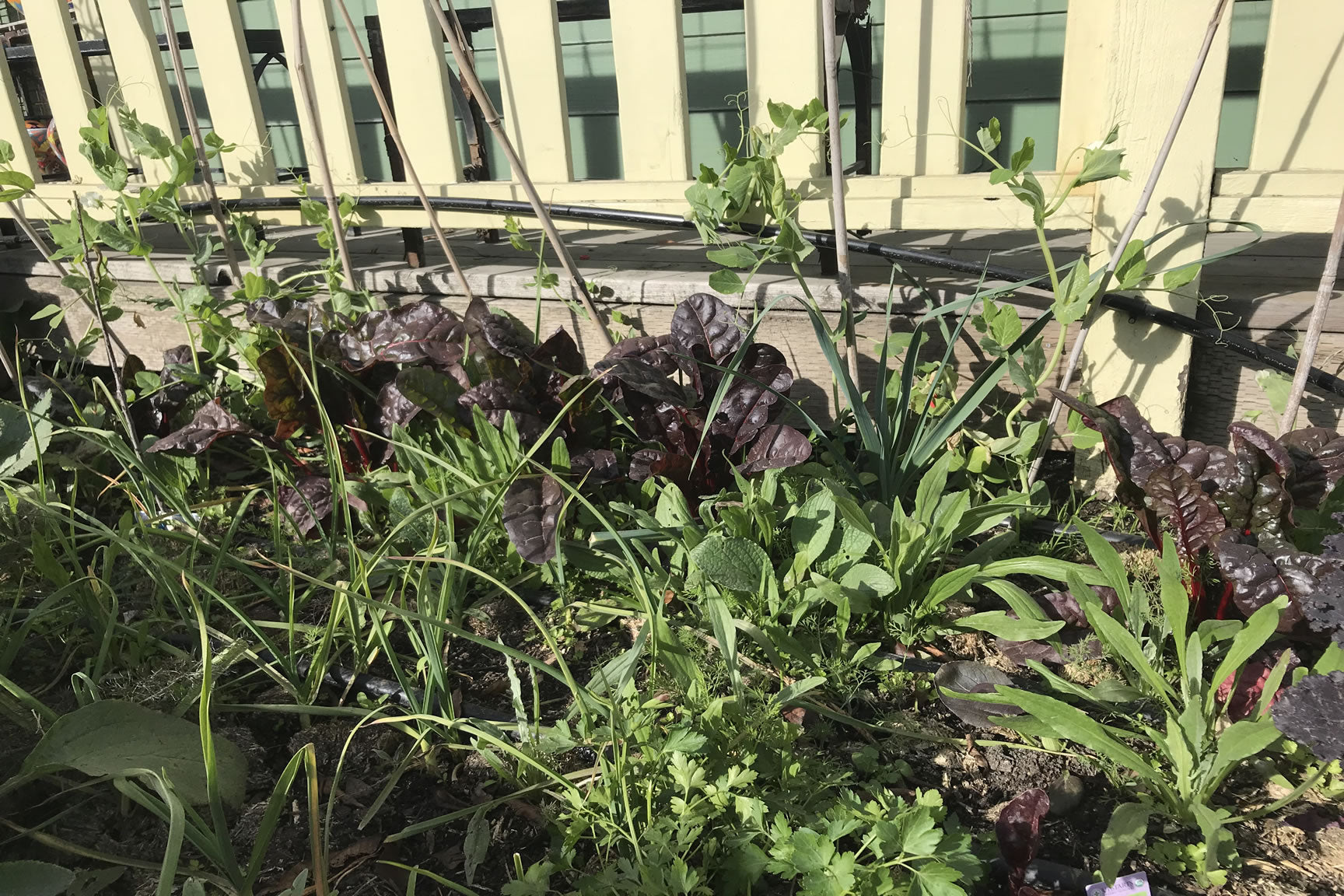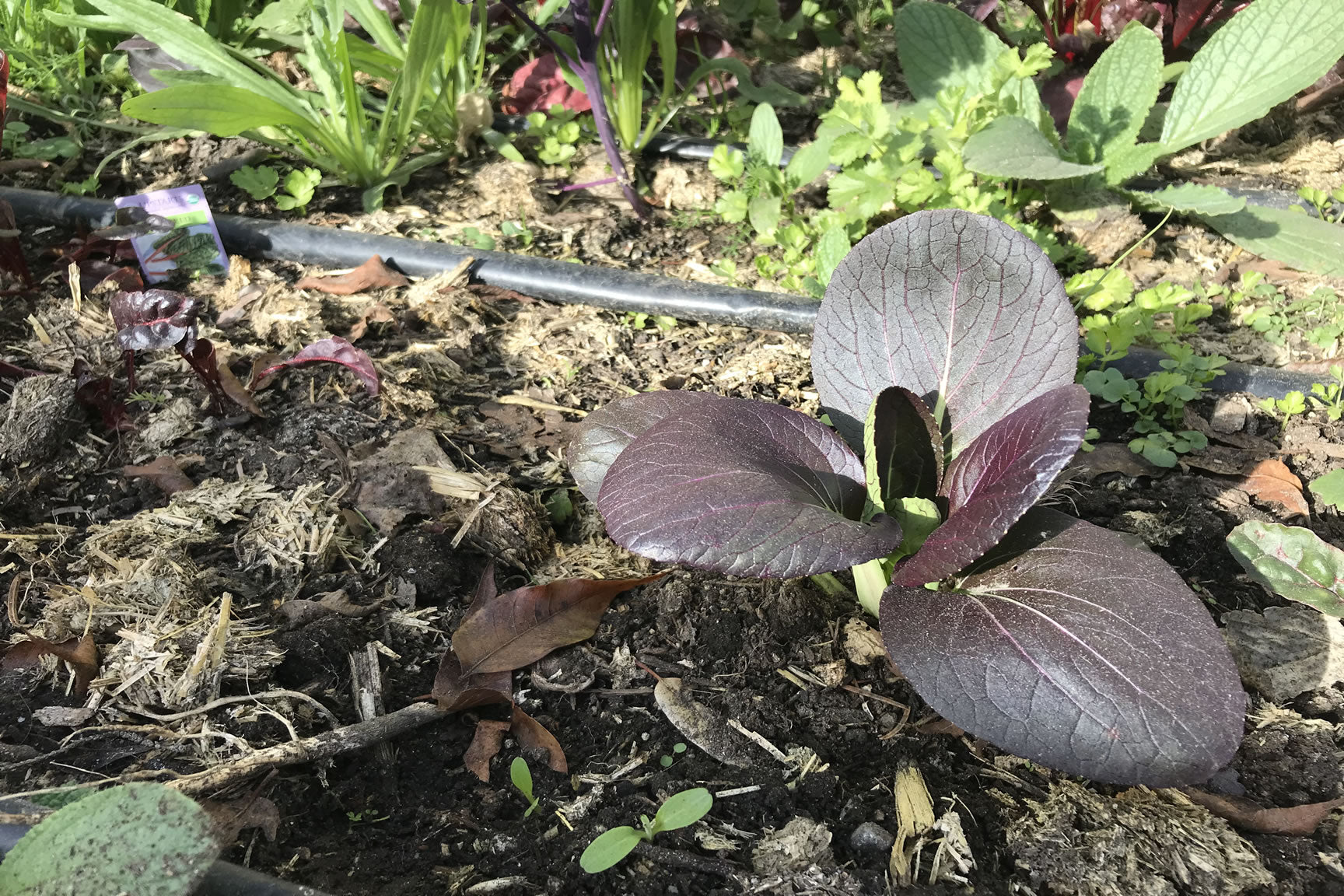- Continue Shopping
- Your Cart is Empty
Garden Notes: January 2018

Lots of weeding in the garden lately, grass and bindweed and burr clover peeping up among the seeded lettuces and wildflowers. It would be easier to be ruthless, and the garden would be more orderly, if we scraped and pulled all the volunteers out, vegetable and weeds alike. But where’s the fun in that? Because we usually let the lettuce, particularly, go to seed, the garden is full, always, of generations of plant friends, popping up, in season and out of it.
 Lettuce that clustered and dropped seed around the stop sign last spring sent up seedlings that we recently transplanted to a sunnier spot, not shaded by the vigorous fava beans. The transplants are doing well, their red ruffled heads like vegetal roses.The red varieties, some kind of butterhead lettuce, seem to be doing better than their lime-green companions, less damaged from the intermittent frost. The young Cosmos seedlings that came up last month are feeling the cold, and will not make it through the month, but the bachelor buttons don’t seem to mind. Some are flowering already, cheerful and bright blue as a spring sky. Lately the weeding challenge has been to tell the difference between the mache and scabiosa seedlings. The mache is one of those seeded crops that knows exactly when to come up. Tomatoes, cosmos, squash and beans have all popped up too early and succumbed to the cold, but the mache knows just when it likes to grow and will not sprout until temperatures and conditions are to its liking. This is a strangely warm year, peppered with occasional freezing nights, so it was something of a relief to know that the mache, at least, is still getting the proper seasonal cues and arriving just on time. It's such a welcome crop, tender and floral in flavor, that nevertheless is one of the hardiest in the winter garden. The seedlings look very much like those of scabiosa, which is everywhere; the difference is a slight scallop in the leaf. We found it the other morning beaded with frost; by noon it was shining with melted dewdrops, looking none the worse for the wear.
Lettuce that clustered and dropped seed around the stop sign last spring sent up seedlings that we recently transplanted to a sunnier spot, not shaded by the vigorous fava beans. The transplants are doing well, their red ruffled heads like vegetal roses.The red varieties, some kind of butterhead lettuce, seem to be doing better than their lime-green companions, less damaged from the intermittent frost. The young Cosmos seedlings that came up last month are feeling the cold, and will not make it through the month, but the bachelor buttons don’t seem to mind. Some are flowering already, cheerful and bright blue as a spring sky. Lately the weeding challenge has been to tell the difference between the mache and scabiosa seedlings. The mache is one of those seeded crops that knows exactly when to come up. Tomatoes, cosmos, squash and beans have all popped up too early and succumbed to the cold, but the mache knows just when it likes to grow and will not sprout until temperatures and conditions are to its liking. This is a strangely warm year, peppered with occasional freezing nights, so it was something of a relief to know that the mache, at least, is still getting the proper seasonal cues and arriving just on time. It's such a welcome crop, tender and floral in flavor, that nevertheless is one of the hardiest in the winter garden. The seedlings look very much like those of scabiosa, which is everywhere; the difference is a slight scallop in the leaf. We found it the other morning beaded with frost; by noon it was shining with melted dewdrops, looking none the worse for the wear.

The brassica, too, are appreciating the occasional cold spell. The leaves of the tree kale have turned a rich purple, and the frilly red kale has deepened in color, as well, raising the antioxidants and also the sweetness of the leaves. It has finally gotten too cold for the cabbage moths, and the Fille de Kraut recovering nicely from the holes chewed in the leaves by the rapacious caterpillars. Brussels sprouts are just starting to lengthen and stretch out their stalk.
We planted garlic and shallots from sets a few months back, and their green shoots have come up, nice and thick. The real work is happening underground, though, where the bulb is forming slowly in the dark earth, layer upon cellular layer. We broke up a six-pack of leeks at the end of December, too, to plant out. One six pack yielded over 50 tiny plants. We will not likely see much rapid growth from them this late in the season (early in the year!) but we expect that they will really take off as the spring begins to creep closer.

The compost pile steams in the mornings, a sign that we have built up the layers well. Raked leaves, spent plants, hay and straw that spilled from the animal feed, all layered to trap tiny air spaces that beneficial compost organisms thrive in. If you stick a gloved hand down into the center of the pile, you can feel the heat coming off of it. It’s metabolism! Everything feeds on something else, even the tiny, invisible microorganisms in the compost pile. Come spring, we’ll empty the bins and spread the compost. The bins are almost full now, but the compost is not done, so as they fill up, we transfer material to the top of the older pile, as it has been digested down a little further. This isn’t ideal, as the material added will have to be removed before we use the finished compost beneath it, but we have limited space in our little roadside jardìn, so it will have to do. In other places, we have used leaves to mulch pathways and spaces between plantings rather than compost the leaves directly. We’ll keep an eye on this method, which can sometimes become habitat for slugs and sowbugs; however, it is also beneficial for the soil and the fungal organisms that live in association with the roots of perennial plants.
The end of the garden got a little facelift recently. The soil in this ares is so poor and rocky, it cannot be used to grow vegetables, despite years of mulching. But poor soil for vegetables can be just the thing for other plants; we have planted it with a variety of California native sages, buckwheats, Baccharis and wildflowers, that thrive in the leaner soil. The coyote brush, particularly, will be welcome when it flowers; it is a valuable insectary plant that is so easy to manage. The native variety that grows in our native soil can get leggy in the wild, but this variety comes from the coast and has the genetics to lay down flat, a much more manageable shape. It can be cut back almost to the ground without ill effect. We look forward to seeing what kind of effect this will have on the insect population in the garden. Planting flowering plants at the edge of the vegetable gardens supports a wider diversity of insect life, which benefits the whole garden. And the world.
It’s a new year, and a good time for planting California natives. The cool weather helps minimize transplant shock, and many CA natives are most actively growing in the cooler weather. Planting native plants now, at the marginal edges of the vegetable garden, gives them a chance to become established before the heat of summer. Do you have places in your garden that could support some more insect habitat? Bonus: beautiful flowers and endless bug watching.
Over to You
It’s part of our mission here at Mountain Feed to help you grow beautiful, sustainable, gardens whether you have sprawling acres of farm or just a tiny plot along the highway. Stop by and say hello on Facebook, Twitter, Instagram or Pinterest. Or, as always, you can do it the old fashioned way and come by the store to speak with one of our in-house experts.
